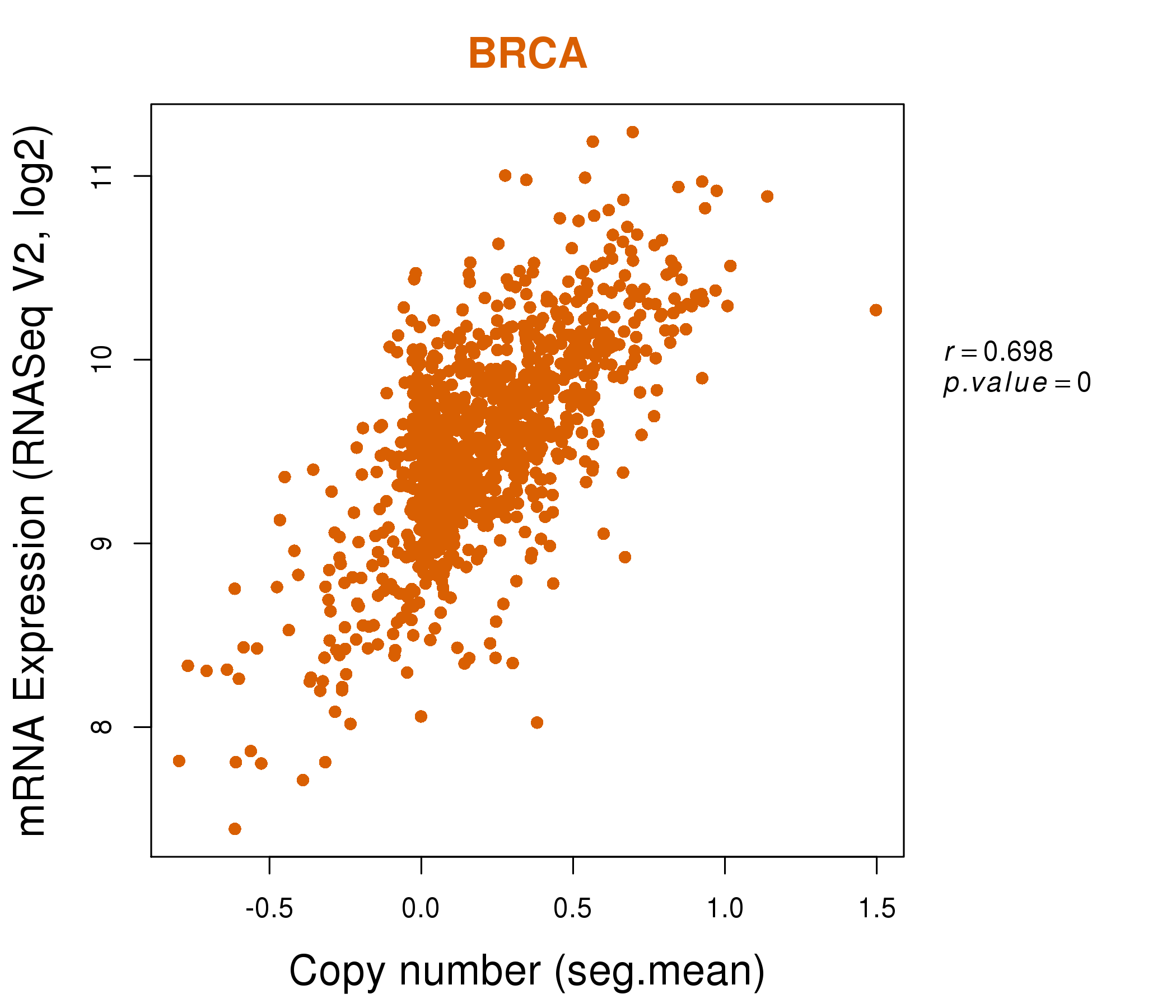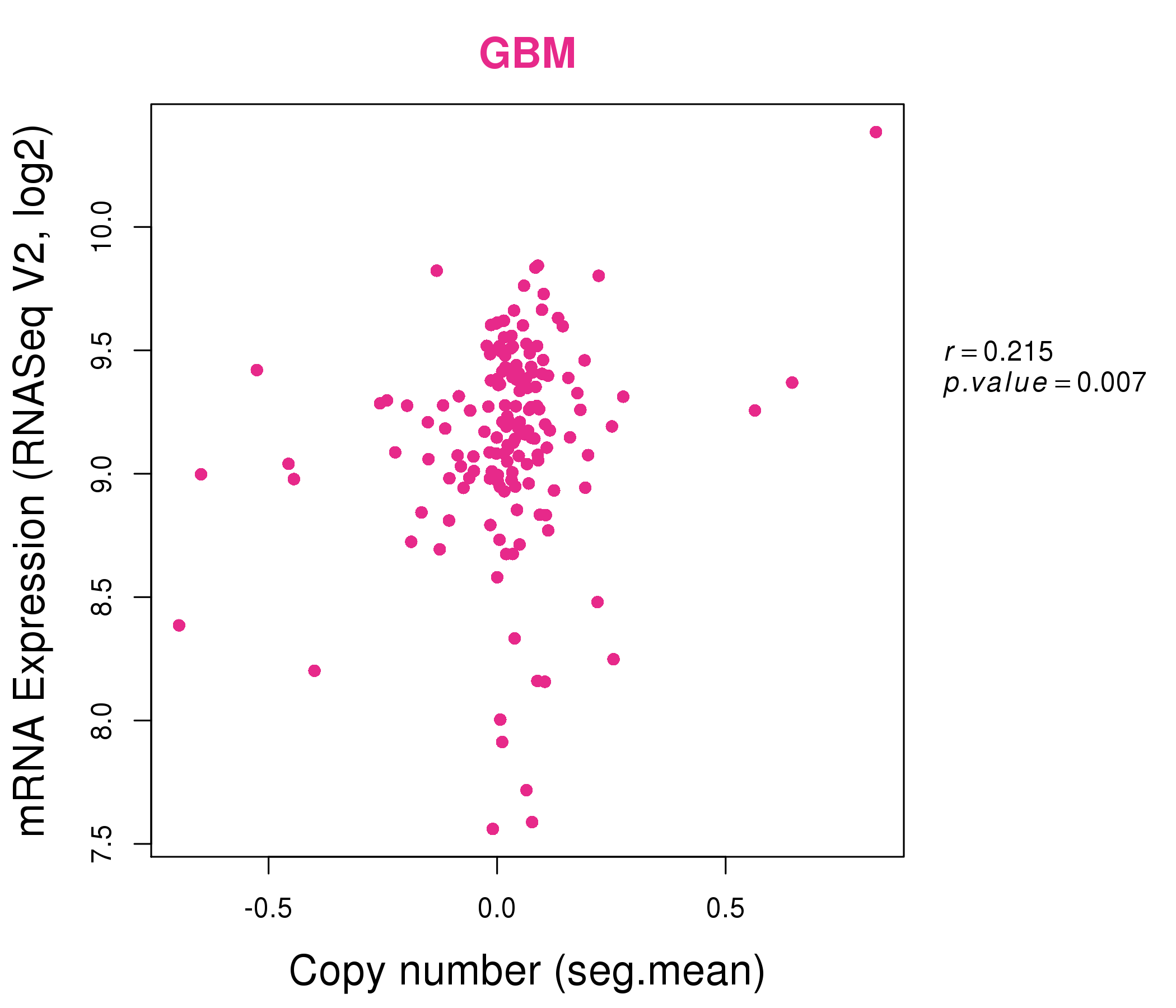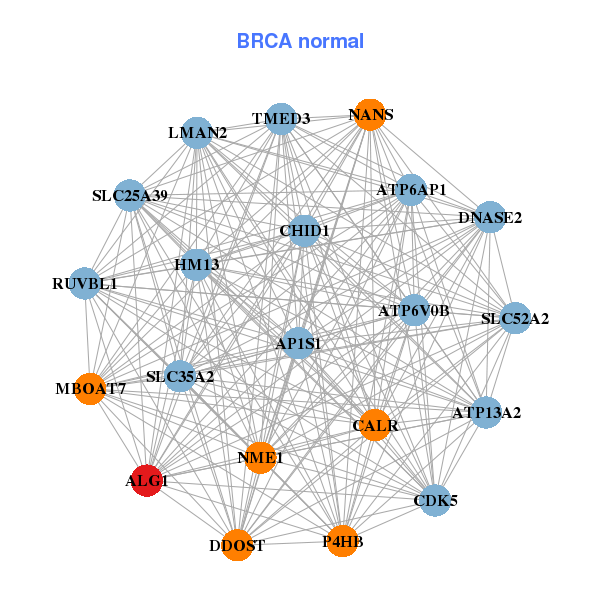|
||||||||||||||||||||
| |
| Phenotypic Information (metabolism pathway, cancer, disease, phenome) |
| |
| |
| Gene-Gene Network Information: Co-Expression Network, Interacting Genes & KEGG |
| |
|
| Gene Summary for ALG1 |
| Basic gene info. | Gene symbol | ALG1 |
| Gene name | ALG1, chitobiosyldiphosphodolichol beta-mannosyltransferase | |
| Synonyms | CDG1K|HMAT1|HMT-1|HMT1|MT-1|Mat-1|hMat-1 | |
| Cytomap | UCSC genome browser: 16p13.3 | |
| Genomic location | chr16 :5121809-5137380 | |
| Type of gene | protein-coding | |
| RefGenes | NM_019109.4, | |
| Ensembl id | ENSG00000033011 | |
| Description | GDP-Man:GlcNAc2-PP-dolichol mannosyltransferaseGDP-mannose-dolichol diphosphochitobiose mannosyltransferaseasparagine-linked glycosylation 1 homolog (yeast, beta-1,4-mannosyltransferase)asparagine-linked glycosylation 1, beta-1,4-mannosyltransferase ho | |
| Modification date | 20141219 | |
| dbXrefs | MIM : 605907 | |
| HGNC : HGNC | ||
| HPRD : 10437 | ||
| Protein | UniProt: go to UniProt's Cross Reference DB Table | |
| Expression | CleanEX: HS_ALG1 | |
| BioGPS: 56052 | ||
| Gene Expression Atlas: ENSG00000033011 | ||
| The Human Protein Atlas: ENSG00000033011 | ||
| Pathway | NCI Pathway Interaction Database: ALG1 | |
| KEGG: ALG1 | ||
| REACTOME: ALG1 | ||
| ConsensusPathDB | ||
| Pathway Commons: ALG1 | ||
| Metabolism | MetaCyc: ALG1 | |
| HUMANCyc: ALG1 | ||
| Regulation | Ensembl's Regulation: ENSG00000033011 | |
| miRBase: chr16 :5,121,809-5,137,380 | ||
| TargetScan: NM_019109 | ||
| cisRED: ENSG00000033011 | ||
| Context | iHOP: ALG1 | |
| cancer metabolism search in PubMed: ALG1 | ||
| UCL Cancer Institute: ALG1 | ||
| Assigned class in ccmGDB | C | |
| Top |
| Phenotypic Information for ALG1(metabolism pathway, cancer, disease, phenome) |
| Cancer | CGAP: ALG1 |
| Familial Cancer Database: ALG1 | |
| * This gene is included in those cancer gene databases. |
|
|
|
|
|
| . | ||||||||||||||
Oncogene 1 | Significant driver gene in | |||||||||||||||||||
| cf) number; DB name 1 Oncogene; http://nar.oxfordjournals.org/content/35/suppl_1/D721.long, 2 Tumor Suppressor gene; https://bioinfo.uth.edu/TSGene/, 3 Cancer Gene Census; http://www.nature.com/nrc/journal/v4/n3/abs/nrc1299.html, 4 CancerGenes; http://nar.oxfordjournals.org/content/35/suppl_1/D721.long, 5 Network of Cancer Gene; http://ncg.kcl.ac.uk/index.php, 1Therapeutic Vulnerabilities in Cancer; http://cbio.mskcc.org/cancergenomics/statius/ |
| REACTOME_METABOLISM_OF_PROTEINS | |
| OMIM | |
| Orphanet | |
| Disease | KEGG Disease: ALG1 |
| MedGen: ALG1 (Human Medical Genetics with Condition) | |
| ClinVar: ALG1 | |
| Phenotype | MGI: ALG1 (International Mouse Phenotyping Consortium) |
| PhenomicDB: ALG1 | |
| Mutations for ALG1 |
| * Under tables are showing count per each tissue to give us broad intuition about tissue specific mutation patterns.You can go to the detailed page for each mutation database's web site. |
| - Statistics for Tissue and Mutation type | Top |
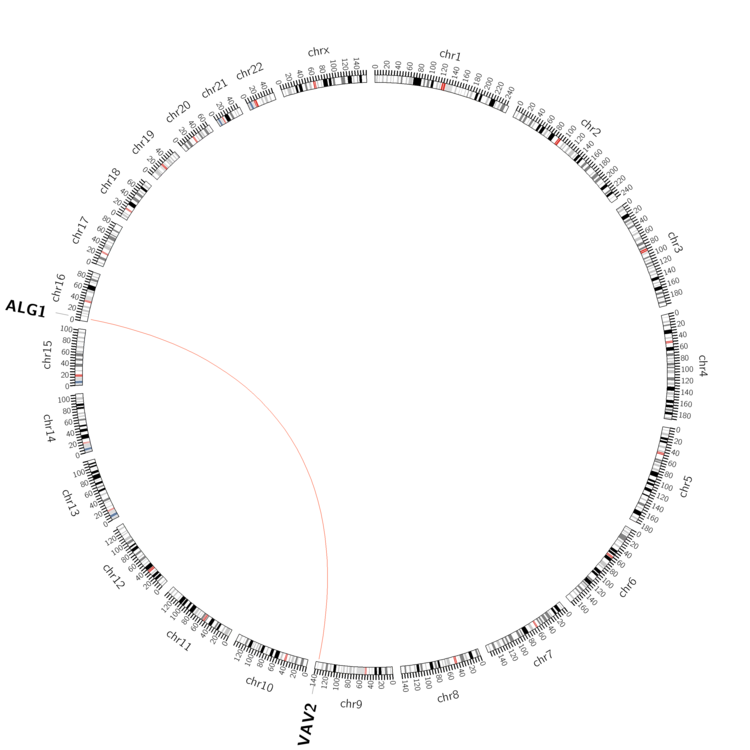 |
| - For Inter-chromosomal Variations |
| * Inter-chromosomal variantions includes 'interchromosomal amplicon to amplicon', 'interchromosomal amplicon to non-amplified dna', 'interchromosomal insertion', 'Interchromosomal unknown type'. |
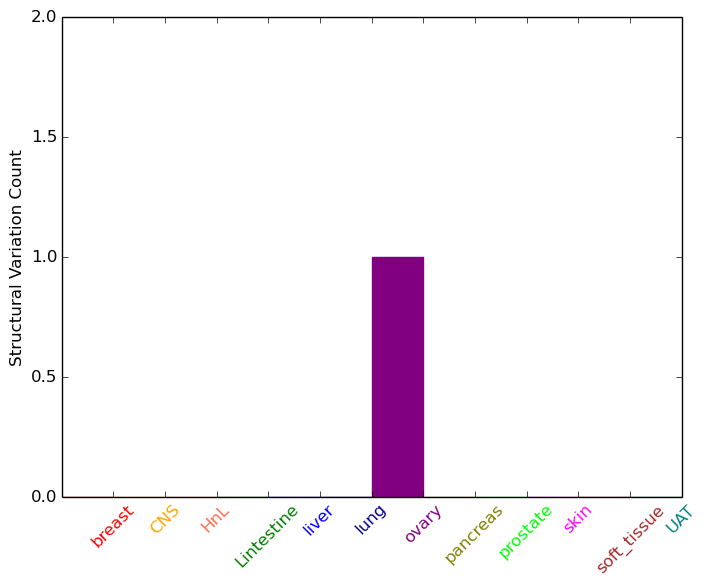 |
| - For Intra-chromosomal Variations |
| There's no intra-chromosomal structural variation. |
| Sample | Symbol_a | Chr_a | Start_a | End_a | Symbol_b | Chr_b | Start_b | End_b |
| cf) Tissue number; Tissue name (1;Breast, 2;Central_nervous_system, 3;Haematopoietic_and_lymphoid_tissue, 4;Large_intestine, 5;Liver, 6;Lung, 7;Ovary, 8;Pancreas, 9;Prostate, 10;Skin, 11;Soft_tissue, 12;Upper_aerodigestive_tract) |
| * From mRNA Sanger sequences, Chitars2.0 arranged chimeric transcripts. This table shows ALG1 related fusion information. |
| ID | Head Gene | Tail Gene | Accession | Gene_a | qStart_a | qEnd_a | Chromosome_a | tStart_a | tEnd_a | Gene_a | qStart_a | qEnd_a | Chromosome_a | tStart_a | tEnd_a |
| Top |
| There's no copy number variation information in COSMIC data for this gene. |
| Top |
|
 |
| Top |
| Stat. for Non-Synonymous SNVs (# total SNVs=29) | (# total SNVs=14) |
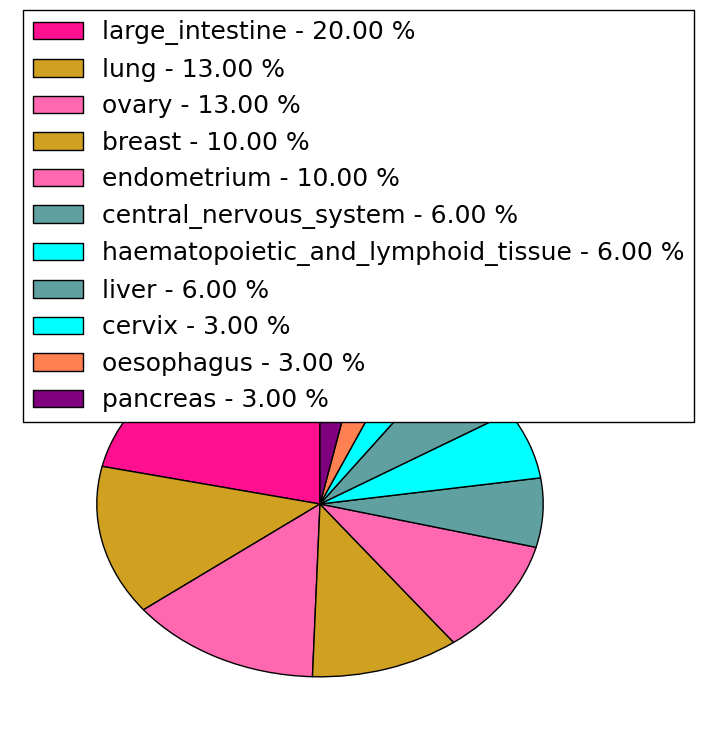 | 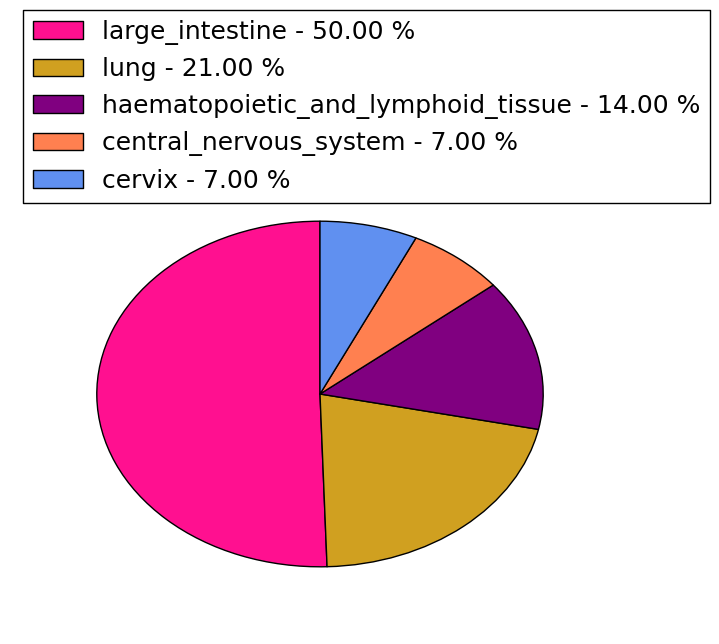 |
(# total SNVs=0) | (# total SNVs=0) |
| Top |
| * When you move the cursor on each content, you can see more deailed mutation information on the Tooltip. Those are primary_site,primary_histology,mutation(aa),pubmedID. |
| GRCh37 position | Mutation(aa) | Unique sampleID count |
| chr16:5129756-5129756 | p.E303E | 4 |
| chr16:5128838-5128838 | p.R274H | 3 |
| chr16:5129771-5129771 | p.D308D | 3 |
| chr16:5123195-5123195 | p.Q110E | 2 |
| chr16:5127458-5127458 | p.F184F | 2 |
| chr16:5123243-5123243 | p.Y126N | 2 |
| chr16:5125427-5125427 | p.F143F | 2 |
| chr16:5128001-5128001 | p.H241H | 2 |
| chr16:5131001-5131001 | p.Q339R | 1 |
| chr16:5121953-5121953 | p.V35L | 1 |
| Top |
|
 |
| Point Mutation/ Tissue ID | 1 | 2 | 3 | 4 | 5 | 6 | 7 | 8 | 9 | 10 | 11 | 12 | 13 | 14 | 15 | 16 | 17 | 18 | 19 | 20 |
| # sample | 2 | 1 | 2 | 5 | 2 | 4 | 4 | 1 | 3 | 4 | 3 | 2 | ||||||||
| # mutation | 2 | 1 | 2 | 5 | 2 | 3 | 2 | 1 | 3 | 3 | 3 | 3 | ||||||||
| nonsynonymous SNV | 2 | 1 | 1 | 4 | 1 | 2 | 1 | 3 | 2 | 3 | 3 | |||||||||
| synonymous SNV | 1 | 1 | 1 | 1 | 2 | 1 |
| cf) Tissue ID; Tissue type (1; BLCA[Bladder Urothelial Carcinoma], 2; BRCA[Breast invasive carcinoma], 3; CESC[Cervical squamous cell carcinoma and endocervical adenocarcinoma], 4; COAD[Colon adenocarcinoma], 5; GBM[Glioblastoma multiforme], 6; Glioma Low Grade, 7; HNSC[Head and Neck squamous cell carcinoma], 8; KICH[Kidney Chromophobe], 9; KIRC[Kidney renal clear cell carcinoma], 10; KIRP[Kidney renal papillary cell carcinoma], 11; LAML[Acute Myeloid Leukemia], 12; LUAD[Lung adenocarcinoma], 13; LUSC[Lung squamous cell carcinoma], 14; OV[Ovarian serous cystadenocarcinoma ], 15; PAAD[Pancreatic adenocarcinoma], 16; PRAD[Prostate adenocarcinoma], 17; SKCM[Skin Cutaneous Melanoma], 18:STAD[Stomach adenocarcinoma], 19:THCA[Thyroid carcinoma], 20:UCEC[Uterine Corpus Endometrial Carcinoma]) |
| Top |
| * We represented just top 10 SNVs. When you move the cursor on each content, you can see more deailed mutation information on the Tooltip. Those are primary_site, primary_histology, mutation(aa), pubmedID. |
| Genomic Position | Mutation(aa) | Unique sampleID count |
| chr16:5129756 | p.E303E | 6 |
| chr16:5125427 | p.R274H | 2 |
| chr16:5128838 | p.F143F | 2 |
| chr16:5127452 | p.Y103H | 1 |
| chr16:5132575 | p.L269P | 1 |
| chr16:5123177 | p.G104R | 1 |
| chr16:5127458 | p.L269L | 1 |
| chr16:5132586 | p.K106I | 1 |
| chr16:5123184 | p.V108I | 1 |
| chr16:5127927 | p.L279L | 1 |
| * Copy number data were extracted from TCGA using R package TCGA-Assembler. The URLs of all public data files on TCGA DCC data server were gathered on Jan-05-2015. Function ProcessCNAData in TCGA-Assembler package was used to obtain gene-level copy number value which is calculated as the average copy number of the genomic region of a gene. |
 |
| cf) Tissue ID[Tissue type]: BLCA[Bladder Urothelial Carcinoma], BRCA[Breast invasive carcinoma], CESC[Cervical squamous cell carcinoma and endocervical adenocarcinoma], COAD[Colon adenocarcinoma], GBM[Glioblastoma multiforme], Glioma Low Grade, HNSC[Head and Neck squamous cell carcinoma], KICH[Kidney Chromophobe], KIRC[Kidney renal clear cell carcinoma], KIRP[Kidney renal papillary cell carcinoma], LAML[Acute Myeloid Leukemia], LUAD[Lung adenocarcinoma], LUSC[Lung squamous cell carcinoma], OV[Ovarian serous cystadenocarcinoma ], PAAD[Pancreatic adenocarcinoma], PRAD[Prostate adenocarcinoma], SKCM[Skin Cutaneous Melanoma], STAD[Stomach adenocarcinoma], THCA[Thyroid carcinoma], UCEC[Uterine Corpus Endometrial Carcinoma] |
| Top |
| Gene Expression for ALG1 |
| * CCLE gene expression data were extracted from CCLE_Expression_Entrez_2012-10-18.res: Gene-centric RMA-normalized mRNA expression data. |
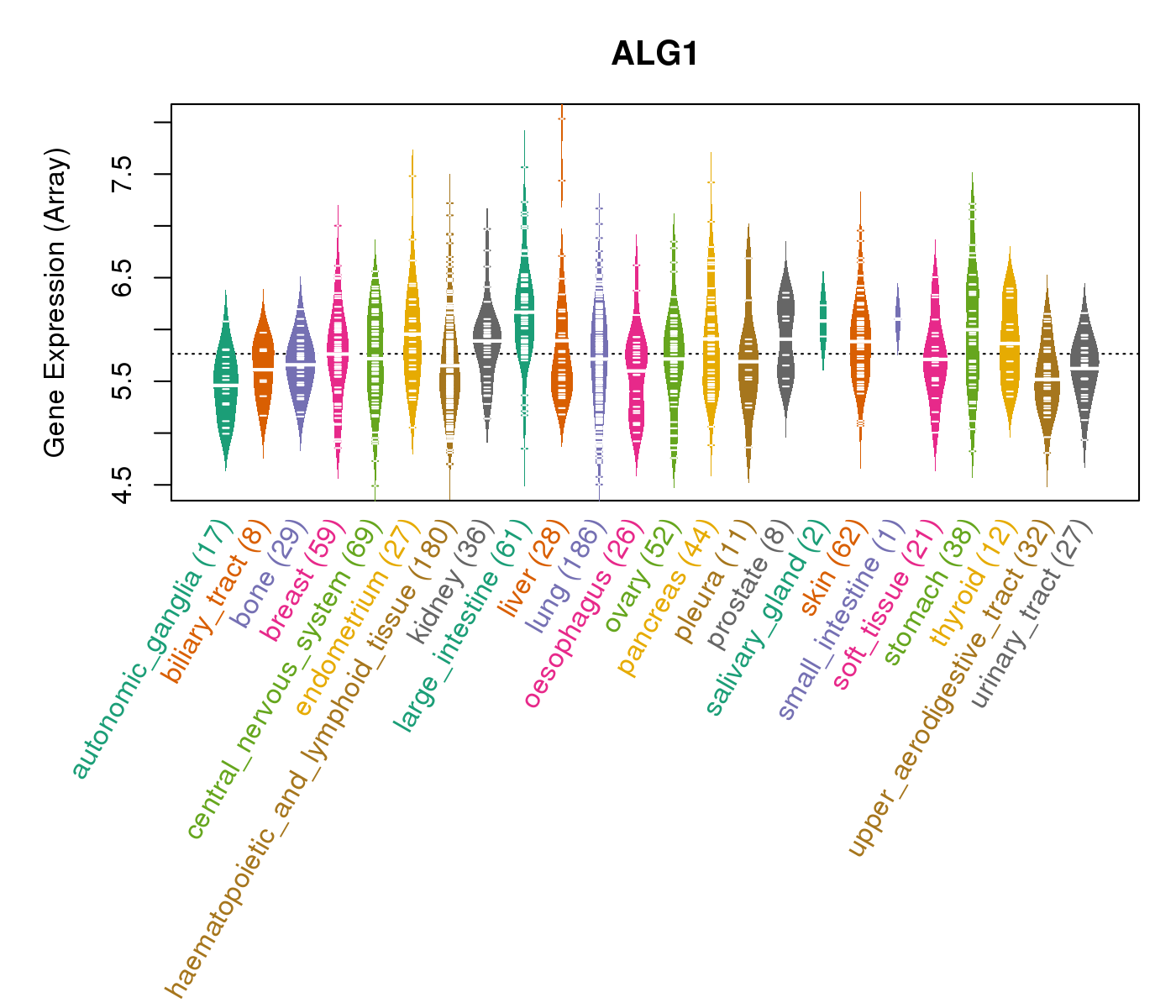 |
| * Normalized gene expression data of RNASeqV2 was extracted from TCGA using R package TCGA-Assembler. The URLs of all public data files on TCGA DCC data server were gathered at Jan-05-2015. Only eight cancer types have enough normal control samples for differential expression analysis. (t test, adjusted p<0.05 (using Benjamini-Hochberg FDR)) |
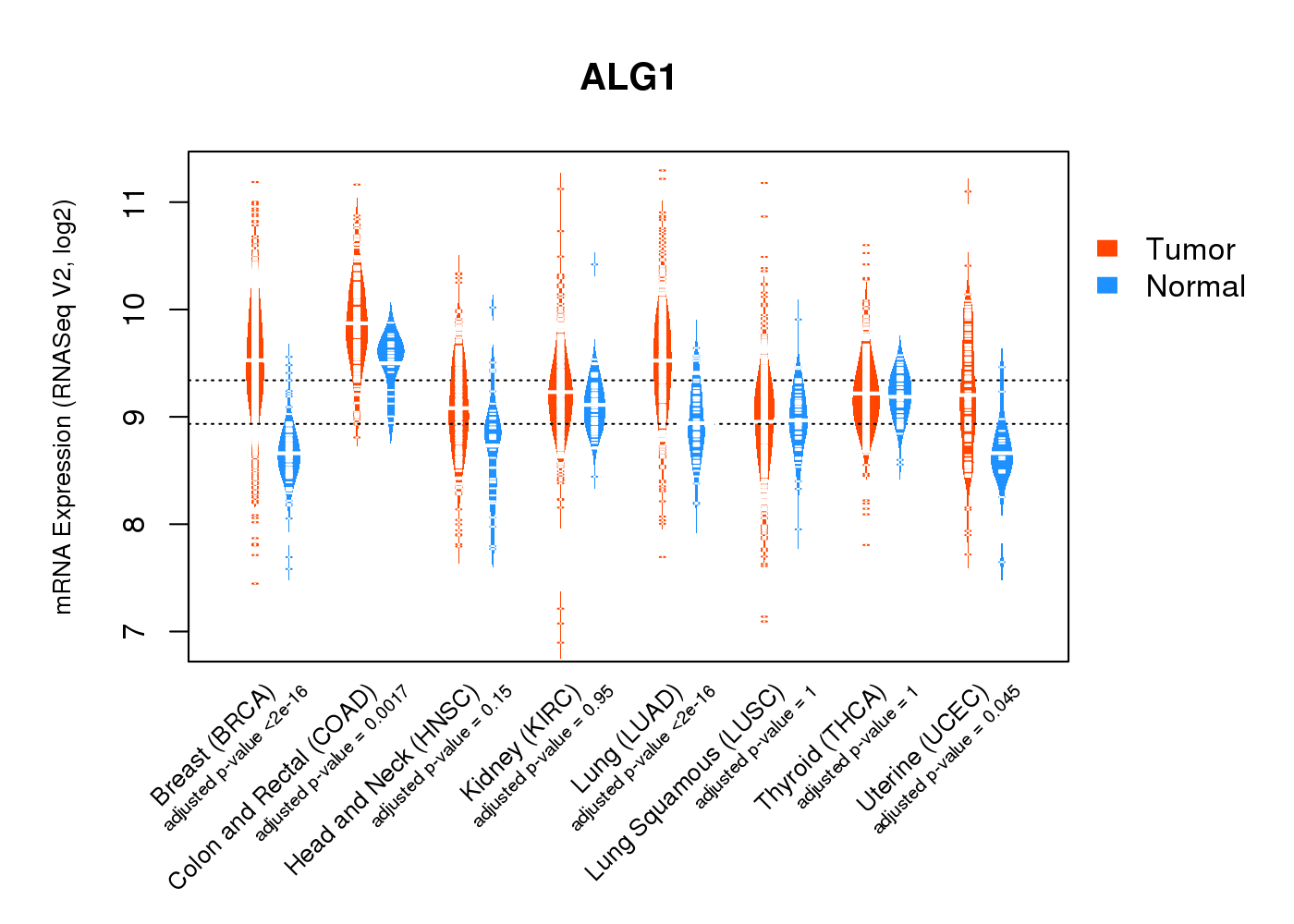 |
| Top |
| * This plots show the correlation between CNV and gene expression. |
: Open all plots for all cancer types
 |
|
 |
|
| Top |
| Gene-Gene Network Information |
| * Co-Expression network figures were drawn using R package igraph. Only the top 20 genes with the highest correlations were shown. Red circle: input gene, orange circle: cell metabolism gene, sky circle: other gene |
: Open all plots for all cancer types
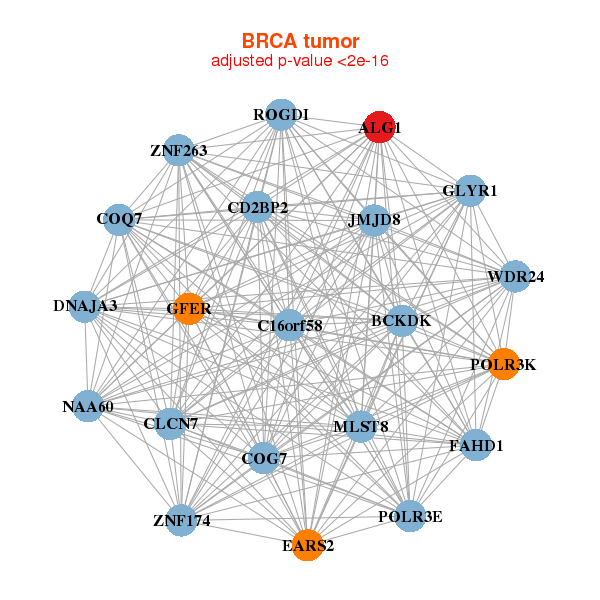 |
|
| ABHD14A,ALG14,ANAPC13,ATP5G2,C12orf57,SMDT1,COX16, COX7C,CYB561D2,DAD1,GABARAP,LAMTOR5,NDUFB1,NDUFC1, NDUFV2,PIGH,RPF1,RWDD3,SLC44A3,TMEM59,YIPF1 | AIDA,AIG1,ALG14,ARL2BP,ATP6V0E1,EMC7,TMEM230, CYB5B,DCTN6,GTF3A,HACL1,LYRM1,MGC72080,MGST1, RHOA,ST7,TMEM14C,UBE2E2,UBE2L3,UBXN8,VPS29 |
 |
|
| ALG14,ATP5C1,ATP5F1,ATP5J,COA6,COMMD8,COX7A2, DPY30,GNG5,LAMTOR5,ITGB3BP,MRPL22,MRPL48,MRPS15, NDUFB1,PSMA5,RBX1,RPL5,SEP15,TOMM22,UQCRQ | ALG14,ATP5C1,ATP5G3,ATPIF1,MPC1,C15orf48,MIEN1, COA3,CLIC1,FAM118B,MLX,MRPL27,MRPS11,NDUFB9, PDCD6,POLR2H,PPCS,TSG101,UQCR10,UQCRFS1,VPS25 |
| * Co-Expression network figures were drawn using R package igraph. Only the top 20 genes with the highest correlations were shown. Red circle: input gene, orange circle: cell metabolism gene, sky circle: other gene |
: Open all plots for all cancer types
| Top |
: Open all interacting genes' information including KEGG pathway for all interacting genes from DAVID
| Top |
| Pharmacological Information for ALG1 |
| There's no related Drug. |
| Top |
| Cross referenced IDs for ALG1 |
| * We obtained these cross-references from Uniprot database. It covers 150 different DBs, 18 categories. http://www.uniprot.org/help/cross_references_section |
: Open all cross reference information
|
Copyright © 2016-Present - The Univsersity of Texas Health Science Center at Houston @ |






